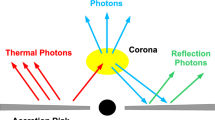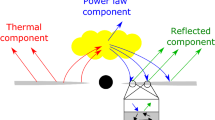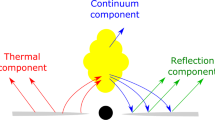Abstract
Accretion processes around relativistic compact objects, such as black holes or neutron stars, can be well studied through X-ray spectroscopy. The disc reflection spectra detected in observations of several active galactic nuclei and X-ray binaries in our and nearby galaxies suggest high steepness of the radial emissivity. This can be primarily caused by compactness of the illuminating radiation. In our recent paper [1], we showed that the measurement of the steep radial emissivity index might also be over-estimated by ignoring the radial ionisation structure and the proper angular-emissivity law, which is non-trivial in the fully relativistic regime. In this paper, we demonstrate the interplay of the angular and radial emissivity. Employing an improper angular emissivity in the reflection models leads to over-estimated values for the black-hole angular momentum and the radial-emissivity index (by about 10 %).
Access provided by Autonomous University of Puebla. Download conference paper PDF
Similar content being viewed by others
Keywords
These keywords were added by machine and not by the authors. This process is experimental and the keywords may be updated as the learning algorithm improves.
1 Introduction
X-ray spectroscopy provides a unique way to study accretion physics in the strong-gravity field. X-ray reflection spectra have been used to measure angular momentum of black holes as well as the other geometrical parameters of the accretion discs, such as its inclination angle, radial emissivity, inner and outer disc radius (for a review, see e.g. [3]). Current relativistic kernels that are applied to reflection models to include the relativistic effects on the spectral shape are based on a series of simplified assumptions and, in particular, they assume a single/broken power-law form of the radial reflection emissivity and an angular emissivity law defined by a simple analytical formula, most frequently employing a limb-darkening profile [4]. Due to the abberation effect and strongly curved photon trajectories, the emission angle is not identical with the inclination angle. It is particularly prominent at the innermost region where it is always very high (see Fig. 1). Such a complex structure implies a non-trivial link between the radial and the angular emissivity when fitting the data.
Contours of the local emission angle, \(\theta _\mathrm{e}(r,\phi )\), near a maximally rotating black hole, \(a=1\), depicted in the equatorial plane \((x,y)\). The black hole and the accretion disc rotate counter clock-wise. The inner region is shown up to \(r=20\) gravitational radii from the black hole. A distant observer is located towards the top of the figure. The inclination angle is 30 (left) and 70\(^{\circ }\) (right). Adopted from [2]
The intrinsic disc radial emissivity is naturally expected to decrease with increasing distance, i.e. the reflection emissivity is
where \(q\) is the emissivity index that can be constant over all radii or a varying quantity. The thermal dissipation of the disc decreases as \(r^{-3}\) [5]. Therefore, the simplest assumption is postulating the same dependence for the reflection. The most energetic photons are produced in the innermost regions, where by consequence the strongest irradiation of the disc occurs. In addition, assuming a point-like X-ray source at height \(h\) on the disc axis, the irradiation of the disc in the absence of any relativistic effect is proportional to \((r^2 + h^2)^{-3/2}\propto r^{-3}\), as shown e.g. by [6]. An emissivity profile with \(q=3\) is therefore considered as standard, while steeper/flatter indices may need to be explained.
Steep emissivity profiles have been measured in X-ray spectra of several active galactic nuclei, such as MCG -6-30-15 [7], 1H0707-495 [8], and IRAS 13224-3809 [9], as well as X-ray binaries with a black hole, such as XTE J1650-500 [10], GX 339-4 [11], and Cyg X-1 [12], or with a neutron star, e.g. Cyg X-2 [13]. The measured indices reach values up to \(q \approx 7\).
Martocchia et al. [14], and Wilkins and Fabian [15] examined whether the required steep emissivity law as well as the predicted equivalent width of the cold reflection line of iron and the Compton reflection component can be reproduced in a phenomenological (lamp-post) model where the X-ray illuminating source is located on the common symmetry axis of the black hole and the equatorial accretion disc. They suggested that the radial emissivity function of the reflection component steepens when the height parameter of the primary irradiation source decreases.
In this paper, we discuss the effect of the angular emissivity in addition to the assumption of the compact centrally localised corona. The reader may also look at [2] and [1], where more geometrical cases are considered as well as the radially dependent ionisation structure (in the latter one). This paper is organised as follows. In Sect. 2, we describe our model set-up. Analytical approaches of the angular emissivity are compared with the numerical one in Sect. 3. Inter-dependence of the angular and radial emissivity is demonstrated in Sect. 4, and the main conclusions are drawn in Sect. 5.
2 Model Pre-requisites
The configuration of a very compact corona located on the rotational axis just above the black hole, known also as the lamp-post scheme, was studied as a simple disc-corona scenario by George and Fabian [16] and Matt et al. [17]. In this scenario, the irradiation far from the source radially decreases as \(r^{-3}\). In the central region, the relativistic effects influence the disc illumination, thus shape the reflection spectra of black hole accretion discs [18]. As a result, the different parts of the disc are irradiated with different intensities, making the emissivity profiles in reflection models distinct from the standard value of \(q=3\). If the height of the source is sufficiently close to the black hole event horizon, light bending implies higher irradiation of the innermost region compared to the outer parts of the disc. The exact profile of the radial emissivity depends on the geometrical properties of the source. Different cases of axial, orbiting, jet, and extended sources were studied by Wilkins and Fabian [15]. The steepest profiles were obtained for point-like sources at small heights along the vertical axis.
The physical set-up of our model is a combination of the general-relativistic lamp-post scheme for an X-ray illuminated accretion disc near a rotating black hole [14] based on the KY package [19] and a self-consistent Monte Carlo scheme for the X-ray reprocessing within the disc environment [20]. We used local (re-) emission tables that were computed by the radiative transfer code NOAR [21] for the case of “cold” reflection (i.e. for neutral or weakly ionised matter). Photo-absorption, Compton scattering, and the fluorescent emission of the iron K line are considered. A stratified plane-parallel atmosphere irradiated by a power law with the photon index \(\varGamma = 1.9\) is assumed. A large number of primary photons were sampled in the 2–300 keV energy range to ensure sufficiently high quality statistics. At all local emission angles, the Poissonian noise level is much smaller than any relevant spectral feature. The computations were done for various incident local emission angles, both polar and azimuthal.
Left Comparison of simple approximations of angular emissivity defined by (2). Right Radial dependence of the incident angle in the lamp-post geometry for different heights. The spin is \(a=1\) and the inclination angle is \(30^{\circ }\)
3 Angular Emissivity: Simple Approximations Versus Numerical Results
The angular emissivity law, \({\fancyscript{M}}(\mu _\mathrm{e},r_\mathrm{e},E_\mathrm{e})\), defines the distribution of the intrinsic intensity outgoing from each radius \(r_\mathrm{e}\) of the disc surface with respect to the perpendicular direction. The emission angle \(\theta _\mathrm{e}=\arccos \mu _\mathrm{e}\) is measured from the disc normal direction to the equatorial plane, in the disc co-moving frame. The general expression is usually simplified to a simple function of \(\mu _\mathrm{e}\). Three cases are the most frequently considered:
Figure 2 (left panel) shows the comparison of these analytical approaches. Limb brightening and limb darkening are completely different. While the limb-darkening law diminishes radiation reflected into high emission angles the limb-brightening profile enhances such a reflected emission. Although limb darkening is the most frequently used approximation in the current spectroscopic analyses, several X-ray simulations of irradiated disc atmospheres suggest the presence of limb brightening (see e.g. [23–25]) instead.
Our results also exhibit the evidence for limb brightening, as shown in Fig. 3. The incident angle plays an important role. A strong limb-brightening effect occurs for grazing incident angles, while almost isotropic dependence is obtained for irradiation of the disc from above. We note that in the strongly curved space-time around a rapidly rotating black hole, the irradiation from “above” does not occur under the lamp, as it would be in the Newtonian physics. In the innermost region, both the incident and emission angles are grazing (see Fig. 1 and the right panel of Fig. 2). This is due to the combined effects of aberration and light bending which grow greatly near the inner rim of the disc.
4 Inter-dependence Between Angular and Radial Emissivity
The angular emissivity is linked with the radial emissivity owing to the significant radial dependence of the emission angle (see Fig. 1). The local emission angle spans the entire range, from \(0\) (perpendicular, face-on) to \(90^{^\circ }\) (grazing, edge-on) degrees. The highest value is obtained in the innermost region, and only far from the centre the emission angle is consistent with the inclination angle, i.e. \(\mu _\mathrm{e}(r,\phi )\rightarrow \mu _\mathrm{obs}\) for \(r\rightarrow \infty \).
Contour plots of the spin \(a\) and the radial emissivity parameter \(q\). The data were generated with the lamp-post model with the height \(h=1.5\,r_\mathrm{g}\). The default value of the spin was \(a=0.94\), which is indicated by a dashed line in the graph. Different prescriptions for the angular emissivity were used: Top left Angular emissivity from numerical calculations. Top right Limb brightening. Bottom left Isotropic. Bottom right Limb darkening. The contour lines correspond to \(1\sigma , 2\sigma \), and \(3\sigma \) levels. Adopted from [1]
Figure 4 shows the contour plots between the black hole angular momentum and the radial emissivity index for different cases of angular emissivity. The simulated data were created with our numerical procedure. The details of the simulations are described in Sect. 2 of [1]. The radial-emissivity index is slightly under-estimated by the model with limb brightening and it is slightly over-estimated by the model with the isotropic angular emissivity. This illustrates the fact that our numerical results do exhibit limb-brightening effect but on average over all incident angles it is not as strong effect as limb brightening defined by the analytical formula in (2). The model with limb darkening clearly produces the worst fit, it over-estimates the radial emissivity index by \(\approx 10\,\%\) and also over-estimates the spin-value.
5 Conclusions
The angular emissivity significantly modifies the total emission expected from the reflection on a black hole accretion disc. The non-trivial dependence of the emission angle on the radial and azimuthal coordinate in the disc implies that (i) there is a link between the radial and angular emissivity, and (ii) the black hole spin measurements via reflection models are affected by the employed angular-emissivity prescription. Our numerical model suggests the presence of limb brightening whose exact profile depends on the incident angle, and thus on the geometry of the primary-radiation source. The strongest limb-brightening effect is obtained for the highest value of the incident angle while almost isotropic dependence is present in the case of irradiation from above. The highest reflection efficiency occurs at the innermost region around a rapidly rotating black hole, where both the incident and emission angles are largest. Averaged over all incident angles, our limb-brightening effect is weaker than the analytical prescription of the limb-brightening law defined by Haardt [22].
References
Svoboda, J., Dovčiak, M., Goosmann, R., et al.: Origin of the X-ray disc-reflection steep radial emissivity. Astron. Astrophys. 545, A106 (2012). doi:10.1051/0004-6361/201219701
Svoboda, J., Dovčiak, M., Goosmann, R., Karas, V.: Role of emission angular directionality in spin determination of accreting black holes with a broad iron line. Astron. Astrophys. 507, 1 (2009). doi:10.1051/0004-6361/200911941
Reynolds, C., Nowak, M.: Fluorescent iron lines as a probe of astrophysical black hole systems. Phys. Rep. 377, 389 (2003). doi:10.1016/S0370-1573(02)00584-7
Laor, A.: Line profiles from a disk around a rotating black hole. Astrophys. J. 376, 90 (1991). doi:10.1086/170257
Novikov, I., Thorne, K.: Black hole astrophysics. In: DeWitt, C., DeWitt, B. (eds.) Black Holes, pp. 343–450. Gordon and Breach, New York (1973)
Reynolds, C., Begelman, M.: Iron fluorescence from within the innermost stable orbit of black hole accretion disks. Astrophys. J. 488, 109 (1997). doi:10.1086/304703
Fabian, A., Vaughan, S., Nandra, K., et al.: A long hard look at MCG-6-30-15 with XMM-Newton. Mon. Not. R. Astron. Soc. 335, L1 (2002). doi:10.1046/j.1365-8711.2002.05740.x
Fabian, A., Zoghbi, A., Ross, R., et al.: Broad line emission from iron K- and L-shell transitions in the active galaxy 1H0707-495. Nature 459, 540 (2009). doi:10.1038/nature08007
Ponti, G., Gallo, L., Fabian, A., et al.: Relativistic disc reflection in the extreme NLS1 IRAS13224-3809. Mon. Not. R. Astron. Soc. 406, 2591 (2010). doi:10.1111/j.1365-2966.2010.16852.x
Miniutti, G., Fabian, A., Miller, J.: The relativistic Fe emission line in XTE J1650–500 with BeppoSAX: Evidence for black hole spin and light-bending effects? Mon. Not. R. Astron. Soc. 351, 466 (2004). doi:10.1111/j.1365-2966.2004.07794.x
Miller, J.: Relativistic X-Ray lines from the inner accretion disks around black holes. Astron. Astrophys. Rev. 45, 441 (2007). doi:10.1146/annurev.astro.45.051806.110555
Fabian, A., Wilkins, D., Miller, J., et al.: On the determination of the spin of the black hole in Cyg X-1 from X-ray reflection spectra. Mon. Not. R. Astron. Soc. 424, 217 (2012). doi:10.1111/j.1365-2966.2012.21185.x
Cackett, E., Miller, J., Ballantyne, D., et al.: Relativistic lines and reflection from the inner accretion disks around neutron stars. Astrophys. J. 720, 205 (2010). doi:10.1088/0004-637X/720/1/205
Martocchia, A., Karas, V., Matt, G.: Effects of Kerr space-time on spectral features from X-ray illuminated accretion discs. Mon. Not. R. Astron. Soc. 312, 817 (2000). doi:10.1046/j.1365-8711.2000.03205.x
Wilkins, D., Fabian, A.: Understanding X-ray reflection emissivity profiles in AGN: Locating the X-ray source. Mon. Not. R. Astron. Soc. 424, 1284 (2012). doi:10.1111/j.1365-2966.2012.21308.x
George, I., Fabian, A.: X-ray reflection from cold matter in active galactic nuclei and X-ray binaries. Mon. Not. R. Astron. Soc. 249, 352 (1991)
Matt, G., Perola, G., Piro, L.: The iron line and high energy bump as X-ray signatures of cold matter in Seyfert 1 galaxies. Astron. Astrophys. 247, 25 (1991)
Miniutti, G., Fabian, A.: A light bending model for the X-ray temporal and spectral properties of accreting black holes. Mon. Not. R. Astron. Soc. 349, 1435 (2004). doi:10.1111/j.1365-2966.2004.07611.x
Dovčiak, M., Karas, V., Yaqoob, T.: An extended scheme for fitting X-Ray data with accretion disk spectra in the strong gravity regime. Astrophys. J. Suppl. Ser. 153, 205 (2004). doi:10.1086/421115
Goosmann, R., Czerny, B., Mouchet, M., et al.: Magnetic flares in active galactic nuclei: modeling the iron K\(\alpha \) line. Astron. Nachr. 327, 977 (2006). doi: 10.1002/asna.200610674
Dumont, A.M., Abrassart, A., Collin, S.: A code for optically thick and hot photoionized media. Astron. Astrophys. 357, 823 (2000)
Haardt, F.: Anisotropic Comptonization in thermal plasmas—spectral distribution in plane-parallel geometry. Astrophys. J. 413, 680 (1993). doi:10.1086/173036
Czerny, B., Różańska, A., Dovčiak, M., Karas, V., Dumont, A.M.: The structure and radiation spectra of illuminated accretion disks in AGN. II. Flare/spot model of X-ray variability. Astron. Astrophys. 420, 1 (2004). doi:10.1051/0004-6361:20035741
Goosmann, R., Mouchet, M., Czerny, B., et al.: Iron lines from transient and persisting hot spots on AGN accretion disks. Astron. Astrophys. 475, 155 (2007). doi:10.1051/0004-6361:20078273
Różańska, A., Madej, J., Konorski, P., Sadowski, A.: Iron lines in model disk spectra of Galactic black hole binaries. Astron. Astrophys. 527, A47 (2011). doi:10.1051/0004-6361/201015626
Author information
Authors and Affiliations
Corresponding author
Editor information
Editors and Affiliations
Rights and permissions
Copyright information
© 2014 Springer International Publishing Switzerland
About this paper
Cite this paper
Svoboda, J., Dovčiak, M., Goosmann, R.W., Karas, V. (2014). On the Interplay Between Radial and Angular Reflection Emissivity from the Black Hole Accretion Disc. In: Bičák, J., Ledvinka, T. (eds) Relativity and Gravitation. Springer Proceedings in Physics, vol 157. Springer, Cham. https://doi.org/10.1007/978-3-319-06761-2_57
Download citation
DOI: https://doi.org/10.1007/978-3-319-06761-2_57
Published:
Publisher Name: Springer, Cham
Print ISBN: 978-3-319-06760-5
Online ISBN: 978-3-319-06761-2
eBook Packages: Physics and AstronomyPhysics and Astronomy (R0)








